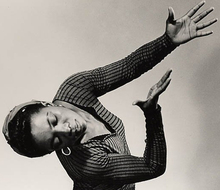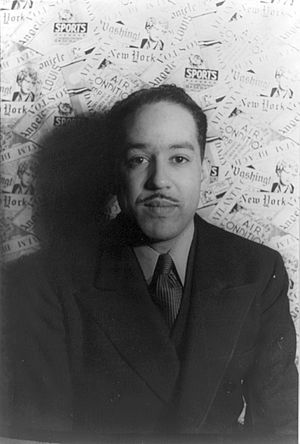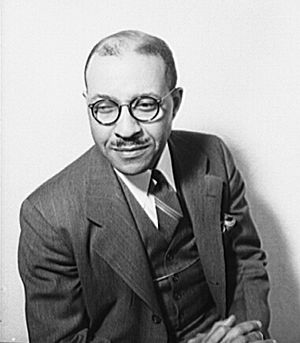Pearl Primus facts for kids
Quick facts for kids
Pearl Primus
|
|
|---|---|

Primus performing The Negro Speaks of Rivers in 1944
|
|
| Born | November 29, 1919 |
| Died | October 29, 1994 (aged 74) New Rochelle, New York, United States
|
| Education | Hunter College New York University |
| Occupation | Choreographer, dancer, anthropologist |
| Spouse(s) | Percival Borde |
| Former groups | New Dance Group |
Pearl Eileen Primus (born November 29, 1919 – died October 29, 1994) was an American dancer, choreographer, and anthropologist. She played a very important part in showing African dance to audiences in America. Early in her career, Pearl Primus saw how important it was to share African dance as a true art form. Her work helped to correct wrong ideas about African people. She wanted the Western world to see African dance as a meaningful and respected way of life.
Contents
Early Life and Dance Journey
Pearl Primus was born in Port of Spain, Trinidad. When she was two years old, in 1921, she moved to New York City with her parents, Edward Primus and Emily Jackson. In 1940, Pearl earned her bachelor's degree in biology from Hunter College. She dreamed of becoming a medical researcher.
However, it was hard for people of color to find jobs in science at that time. Because of these challenges, Pearl could not find work as a lab technician. She also could not afford medical school. So, she took different small jobs. Eventually, the National Youth Administration helped her get a job. She worked backstage in the wardrobe department for a show called America Dances.
When a dancer spot opened up, Pearl was hired as an understudy. This was her first time working in theater. Pearl quickly found out she had a natural talent for movement. People soon noticed her amazing skills. Within a year, she tried out and won a scholarship. This allowed her to join the New Dance Group. This was a dance school and performance company in New York City.
Starting a Dance Career
Pearl Primus began her formal dance studies with the New Dance Group in 1941. She was the first black student in the group. She learned from the group's founders, Jane Dudley, Sophie Maslow, and William Bates. Through this group, Pearl learned modern dance techniques. She also learned about using art to speak out for change.
The New Dance Group's motto was "dance is a weapon of the class struggle." This meant they believed dance could make a strong statement. They taught dancers like Pearl to be aware of the political and social issues of their time. This new way of thinking encouraged Pearl to create dances that protested social problems.
Pearl continued to improve her modern dance skills. She studied with famous dancers like Martha Graham, Charles Weidman, and Asadata Dafora. Dafora especially helped Pearl feel proud of African culture. He taught her about African dance and traditions. This led to more public interest in her work.
Pearl researched African culture and dance by talking to family, reading books, and visiting museums. After six months of hard work, she created her first big dance piece. It was called African Ceremonial. This dance showed her growing interest in Black heritage. It was based on an old legend from the Belgian Congo.
Pearl performed African Ceremonial along with other dances like Strange Fruit and Hard Time Blues. Her first show was on February 14, 1943. It took place at the 92nd Street YMHA. Her performance was so good that John Martin, a major dance critic for The New York Times, said she deserved her own dance company. He admired her stage presence, energy, and technique. He called her a truly remarkable artist.

After getting much praise, Pearl Primus began performing in April 1943. She was an entertainer at the famous Cafe Society Downtown nightclub. For 10 months, her energy and emotion filled the stage. Her amazing five-foot-high jumps impressed everyone. She continued to wow audiences in June 1943. She performed at the Negro Freedom Rally at Madison Square Garden for 20,000 people.
In December 1943, Pearl performed in Dafora's African Dance Festival at Carnegie Hall. Important people like Eleanor Roosevelt and Mary McLeod Bethune were in the audience. In the same month, Pearl, who mostly performed alone, started her own group called the Primus Company. They performed concerts at the Roxy Theatre. Pearl re-imagined African Ceremonial for her group. At this time, her African dances were based on her research and how she saw her findings. For example, she would imagine the movements of an African sculpture and turn them into dance.
Researching Dance and Culture
Over time, Pearl became very interested in how dance showed the lives of people in different cultures. She was also curious about the connection between the African slave diaspora and various cultural dances. With this wider interest, Pearl began to do field studies.
In the summer of 1944, Pearl visited the Deep South of the United States. She wanted to research the culture and dances of Black people there. She pretended to be a migrant worker. Her goal was "to know [her] own people where they are suffering the most." She lived and worked with poor sharecroppers. Pearl fully joined their daily lives. She went to over seventy churches and picked cotton with them. After this research, Pearl created new dances. She also improved some of her older works.
Pearl made her Broadway debut on October 4, 1944. She performed a dance based on Langston Hughes’ poem "The Negro Speaks of Rivers". This poem talked about unfairness and injustice faced by the Black community. It compared the history of Black people to four major rivers. Pearl’s dance bravely showed the strength and wisdom of African Americans through times of freedom and slavery.
In 1945, she continued to develop Strange Fruit. This was one of the pieces she first performed in 1943.
Pearl’s work kept pushing boundaries. She re-developed another one of her early pieces, Hard Time Blues (1945). She created this dance to a song by folk singer Josh White. This dance protested sharecropping. It truly showed Pearl’s unique movement style. The dance had amazing athletic jumps that seemed to defy gravity. But Pearl explained that jumping does not always mean joy. In this dance, her powerful jumps showed the defiance, desperation, and anger of the sharecroppers. She had seen these feelings firsthand during her research. Pearl believed it was important to notice "the shape the body takes in the air" during jumps. For Hard Time Blues, the body's shape showed the emotional state of the poor sharecroppers.
In 1946, Pearl continued her journey on Broadway. She was invited to be in the show Show Boat. Then, she was asked to choreograph a Broadway show called Calypso, which later became Caribbean Carnival. She also performed at the Chicago Theatre in 1947. She played the "Witch Doctor" role in Emperor Jones.

In 1947, Pearl joined Jacob's Pillow. She started her own program there. She performed some of her works again, like Hard Time Blues. She also presented three spirituals: "Motherless Child," "Goin’ to tell God all my Trouble," and "In the Great Gettin’-up Mornin’." These dances came from Pearl’s experiences with Black southern culture. These "sorrow songs" came from slave culture. Many modern dancers at the time found inspiration in them.
After this show, Pearl toured the country with The Primus Company. While performing at universities, she visited Fisk University in 1948. Dr. Charles S. Johnson, who was part of the Rosenwald Foundation, was the president there. He was so impressed by her African dances. He asked her when she had last visited Africa. She said she had never been.
Pearl then received the largest amount of money ($4000) ever given by the Rosenwald Foundation. With this money, she decided to go on an 18-month research trip to Africa. She visited places like the Gold Coast, Angola, Cameroons, Liberia, Senegal, and the Belgian Congo. On December 5, 1948, Pearl Primus finished a successful return performance at the Café Society nightclub in New York City before leaving for Africa.
African Journeys and Later Work
In Africa, Pearl was welcomed into many communities. People in Ife, Nigeria, felt she was so much a part of their community. They gave her the title "Omowale," which means "the child who has returned home." During her travels, Pearl was even declared a man. This allowed her to learn dances that were only taught to males. She mastered dances like Bushasche, a war dance, and Fanga, which were common in African life.
When Pearl returned to America, she used her new knowledge. She created dances for the Alvin Ailey American Dance Theatre. In 1974, Pearl staged Fanga. This was a Liberian welcome dance she created in 1949. It became a famous part of her work. She also staged The Wedding (created in 1961). These dances were based on the African rituals Pearl experienced during her travels. Pearl took these long traditional rituals, made them shorter for the stage, and kept the true spirit of the movements.
Pearl learned a lot in Africa, but she still wanted to learn more academically. She earned her PhD in anthropology from NYU in 1978. In 1979, she and her husband, Percival Borde, started the Pearl Primus "Dance Language Institute" in New Rochelle, New York. They taught classes that mixed African-American, Caribbean, and African dance styles with modern dance and ballet. They also formed a performance group called "Earth Theatre."
As an artist and teacher, Pearl taught at many universities. These included NYU, Hunter College, and Howard University. As an anthropologist, she worked on cultural projects in Europe, Africa, and America for various organizations.
Legacy and Impact
A Pioneer of African Dance
Pearl Primus's trip to West Africa was very important for students of African dance. She learned more about African dance, its purpose, and its meaning than any other American before her. Pearl was known as a griot. This means she was like a storyteller or voice for cultures where dance is a big part of life. She wrote down the technical details of many African dances. She also helped save some "gems of dances" before they were lost. She was always happy to share what she learned with others.
Pearl's African research and dances were important for many reasons. They showed a dance history that brought different groups together. They created a strong foundation for future African dancers. They turned African dance forms into a disciplined art. And they made American theater richer by bringing African dance to the stage.
Pearl and her husband, Percival Borde, also worked with the Liberian Konama Kende Performing Arts Center. They helped create a performing arts center. They also organized dance performances in different places between 1959 and 1962. Pearl and Percival taught African dancers how to make their traditional dances entertaining for Western audiences. They also helped bring African dance companies from countries like Senegal and Guinea to the United States.
Her Unique Dance Style
Pearl Primus's way of creating movement and dances was similar to other pioneers of American modern dance. These artists looked to books, music, and different cultures for ideas.
However, Pearl found her main inspiration in the cultural heritage of African Americans. She learned a lot from her family. They told her about their West Indian roots and African family history. These stories gave young Pearl a cultural and historical background. This became the foundation for her creative works. Her detailed studies in the South and in Africa were also key resources. She made sure to keep the traditional forms of expression she saw. This was different from other dance groups who changed African dances in their performances. Pearl believed "dance as a form of life." This supported her choice to keep her dances real and true to their origins.
Pearl combined spirituals, jazz, and blues music. She also used the writings of Black authors. Her dances, like Strange Fruit, Negro Speaks of Rivers, and Hard Time Blues, spoke about important social topics. Her efforts to bring about political and social change through dance make her one of the most impactful choreographers of her time. She was very aware of the issues faced by African Americans, especially between World War I and II.
Pearl Primus was a powerful dancer. Her emotions, energy, and five-foot-high athletic jumps amazed every audience. One critic described her performance of Hard Time Blues: "Pearl takes a running jump, lands in an upper corner and sits there, unconcernedly paddling the air with her legs. She does it repeatedly, from one side of the stage, then the other, apparently unaware of the involuntary gasps from the audience…" Her athleticism made her dances incredible to watch. She kept traditional movements but added her own style. This included special pelvic rotations and rhythmic changes. When she moved, Pearl showed great intensity and passion. At the same time, she brought attention to important social issues.
Pearl strongly believed that rich dance material came from the deep experiences of people. This idea has been picked up by other famous choreographers like Alvin Ailey and Donald McKayle. Her work has also been re-imagined by modern artists. Many choreographers, like Jawole Willa Jo Zollar, have created projects inspired by Pearl’s work. Pearl’s dance style, which included bent knees, moving different body parts separately, and rhythmic, strong movements, can be seen in the dances of Zollar and many others. These similarities show that Pearl’s style and themes helped bring Black culture to the dance world.
Personal Life and Death
Pearl Primus married dancer, drummer, and choreographer Percival Borde in 1954. They worked together until his death in 1979. In 1959, Pearl earned a Master's degree in education from New York University. That same year, she traveled to Liberia. There, she worked with the National Dance Company to create Fanga. This dance was an interpretation of a traditional Liberian prayer to the earth and sky.
Pearl Primus believed in careful research. She thoroughly searched libraries and museums. She also learned from living people. This made her a respected dance scholar.
Pearl Primus focused on important issues like unfair treatment, prejudice, and violence. The United States government also supported her efforts to promote African-American art.
Pearl Primus died from diabetes at her home in New Rochelle, New York, on October 29, 1994.
Recognition and Awards
In 1991, President George H. W. Bush honored Pearl Primus with the National Medal of Arts. She received many other awards, including:
- The "Star of Africa" from the Liberian Government.
- The Scroll of Honor from the National Council of Negro Women.
- The Pioneer of Dance Award from the Alvin Ailey American Dance Theatre.
- Membership in Phi Beta Kappa.
- An honorary doctorate from Spelman College.
- The first Balasaraswati/Joy Ann Dewey Beinecke Chair for Distinguished Teaching at the American Dance Festival.
- The National Culture Award from the New York State Federation of Foreign Language Teachers.
- A commendation from the White House Conference on Children and Youth.
Images for kids
-
Primus studied under Martha Graham (photographed in 1948)
See also
 In Spanish: Pearl Primus para niños
In Spanish: Pearl Primus para niños


